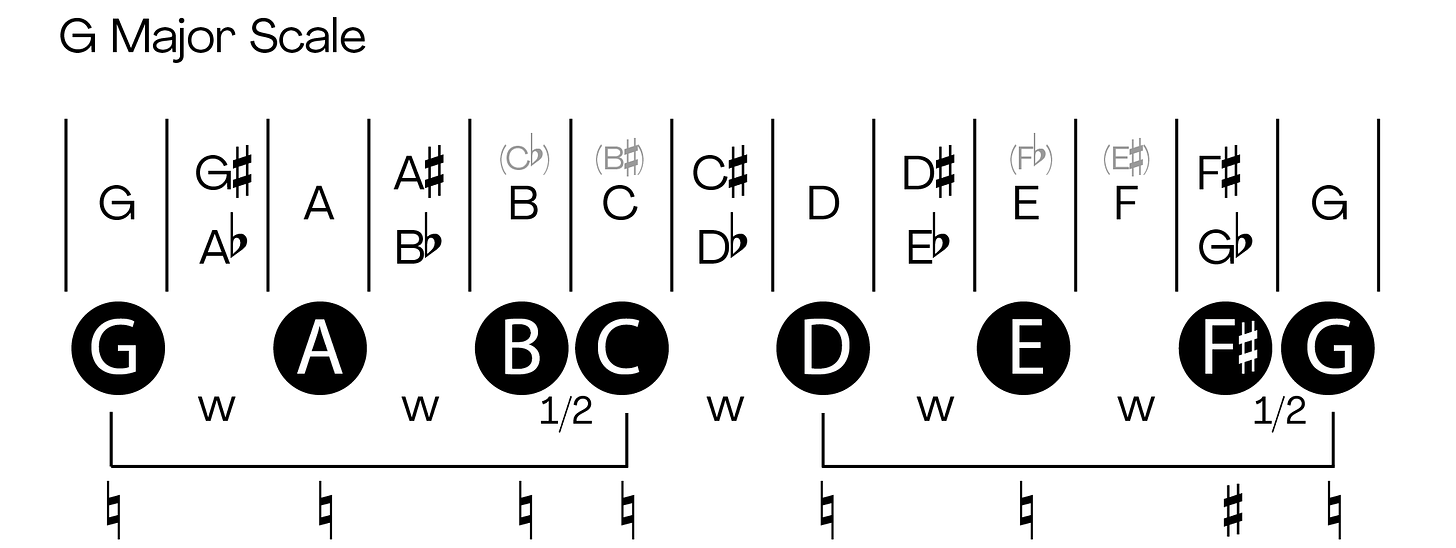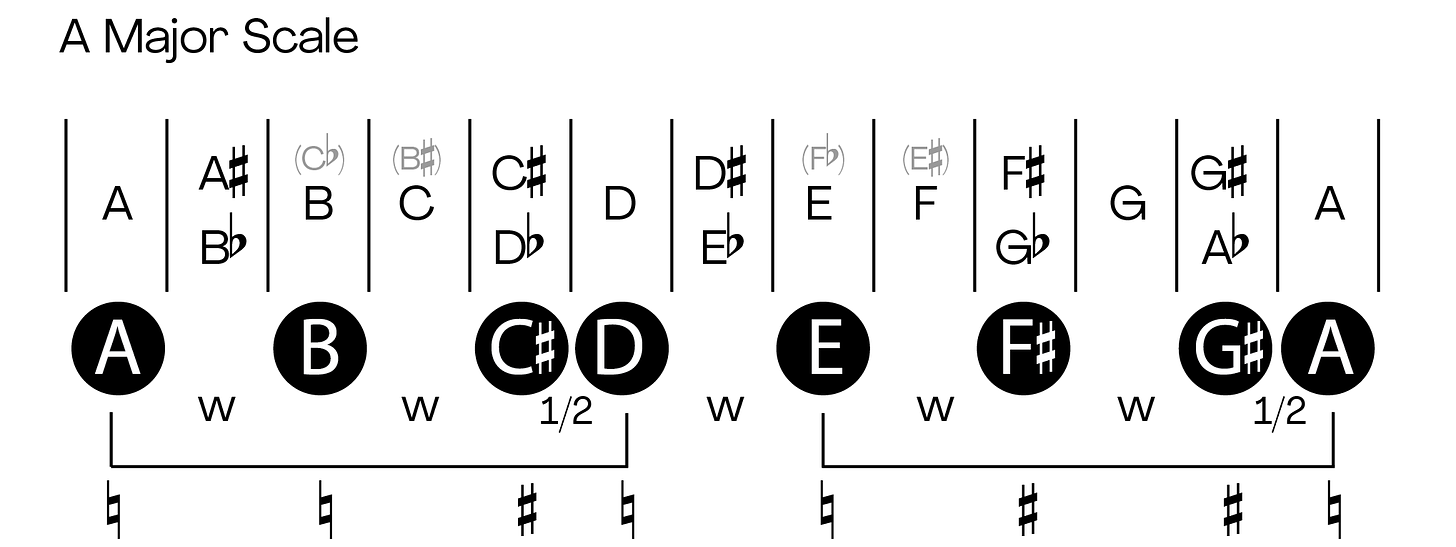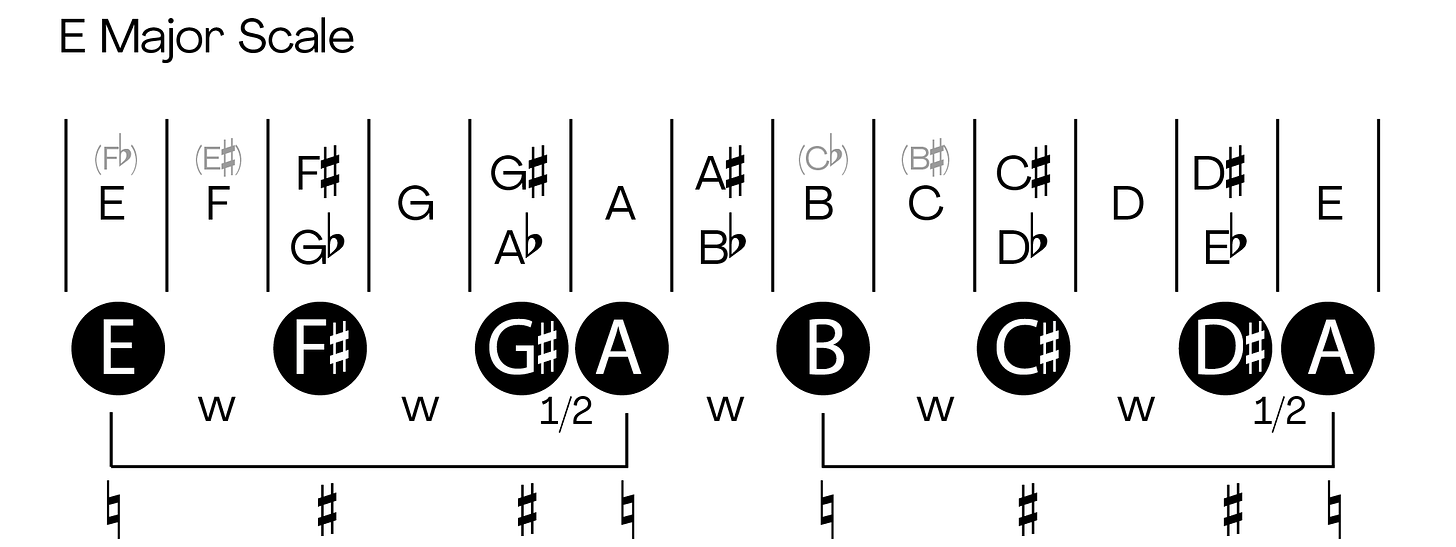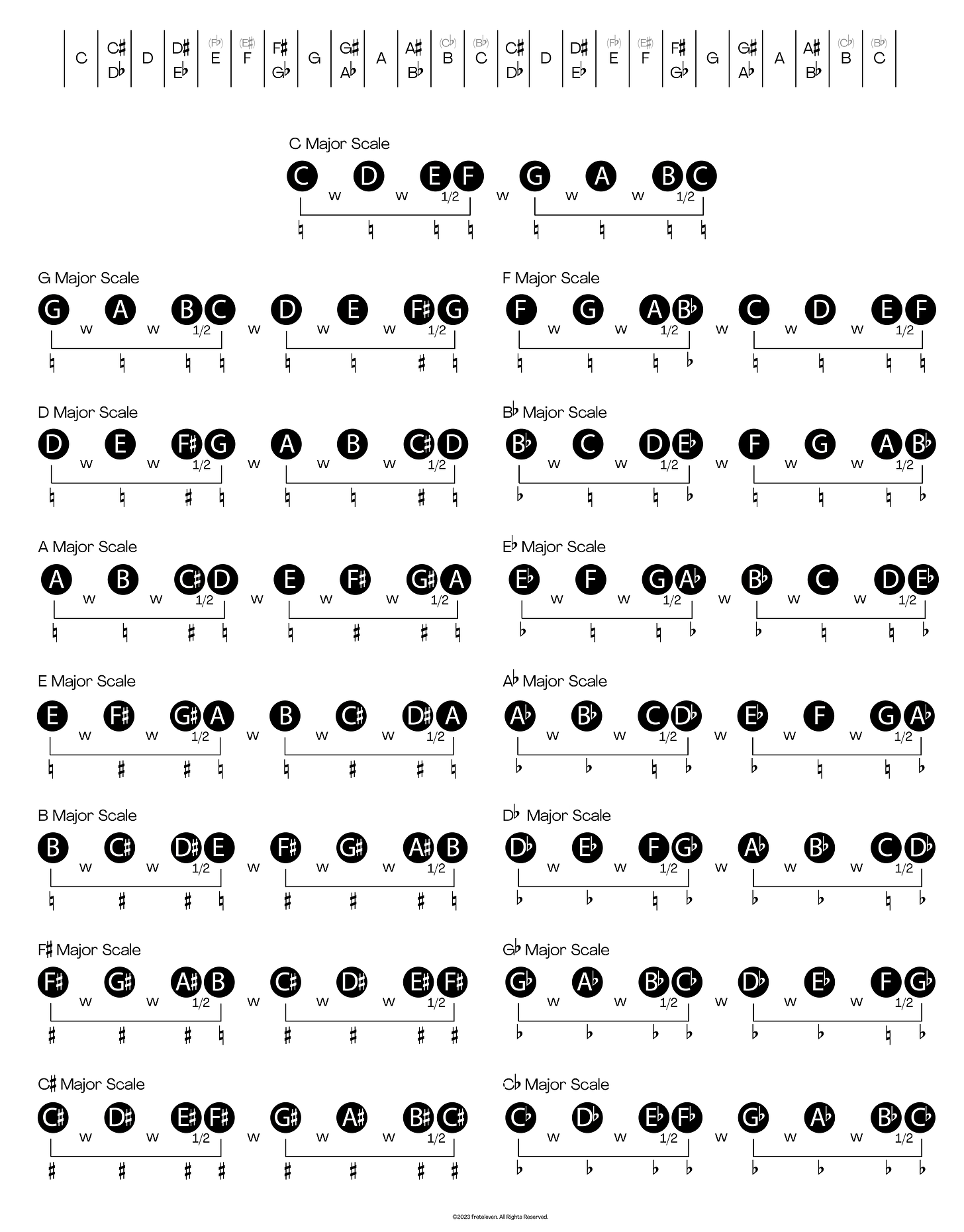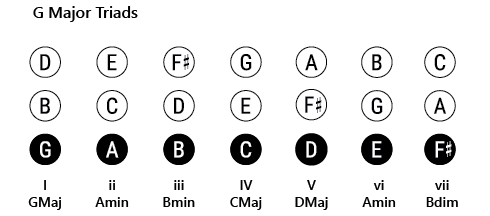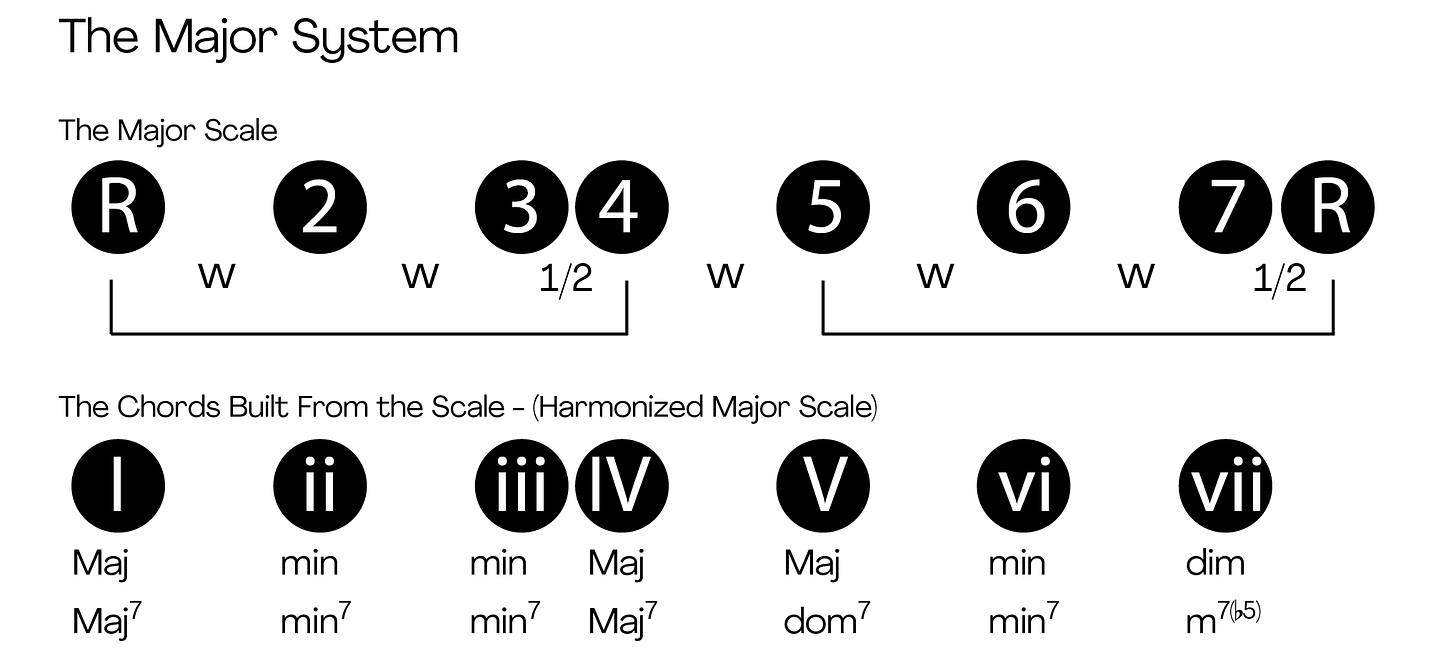Knowing Your Major Scales: A Definitive Guide
The foundation for musically understanding keys, chords, and the fretboard
There’s a gap a lot of guitarists hit: you’ve learned scale shapes on the fretboard, put in the time memorizing positions, practiced the patterns. But when someone says “let’s play this in A Major,” you freeze. When theory gets discussed, you check out. Keys, scales, chord progressions, it feels like foreign language.
What’s happening is you learned where to put your fingers without learning what notes you’re playing or why those notes work together. You skipped the foundation and went straight to the guitar.
Every song you’ve ever loved, every melody, every chord progression, is built on the major scale. The Beatles. Hendrix. Your favorite jazz player. That country song stuck in your head. Even the most complex music traces back to this single pattern of seven notes.
A lot of guitarists don’t learn this system. They learn bits and pieces (a shape here, a position there) without understanding what key they’re in, what notes belong to that key, or how chords are built from those notes.
Often we try to learn theory on the guitar before understanding it conceptually. That’s backwards.
This guide is about understanding the major scale in all 12 keys before you touch the guitar.
Here’s what this covers:
What notes are in each key
The pattern that creates major scales
How chords are built from scale notes
How to get this knowledge automatic (when someone says “D♭ Major,” you instantly know the seven notes)
This takes work. Memorization. Repetition. Time with flashcards and diagrams until it becomes automatic. But once you have this foundation? Everything on the guitar makes sense. Shapes become notes. Patterns become keys. Theory becomes a description of what you already understand.
We’ll start with the chromatic scale, move through all 12 major scales (15 if we count enharmonic spellings), show you how chords are built from scales, and end with how to take this knowledge to the fretboard.
The Foundation: Understanding the Chromatic Scale
First, we map out all 12 notes available in Western music. This is the chromatic scale, every note, every half step, laid out in order.
Think of it like a piano keyboard laid out horizontally. Not a piano, the visual layout showing you all available notes.
The 12 Notes (Starting from C):
C - C♯/D♭ - D - D♯/E♭ - E - F - F♯/G♭ - G - G♯/A♭ - A - A♯/B♭ - B - (C)
Notice: some notes have two names. C♯ and D♭ are the same pitch but spelled differently. These are called enharmonic equivalents.
Why Enharmonic Spelling Matters
The common sharp/flat names aren’t enough. To understand scales and keys, you’ll want to know ALL the enharmonic possibilities, including the weird ones:
E = F♭ (F-flat)
F = E♯ (E-sharp)
B = C♭ (C-flat)
C = B♯ (B-sharp)
Why? Because when you’re in the key of F♯ major, you’ll have E♯ (not F). When you’re in G♭ major, you’ll have C♭ (not B). Each major scale uses each letter name exactly once. No repeats. No skips.
This is the logic of the system. Understanding this now makes everything else click.
The Major Scale Pattern
The major scale is a specific pattern carved out of the chromatic scale. Seven notes that create that bright, “do-re-mi-fa-sol-la-ti-do” sound you know instinctively.
Here’s the pattern:
Whole and Half Steps: W-W-H-W-W-W-H
Starting from any note, follow this:
Whole step (skip one note in the chromatic scale)
Whole step
Half step (move to the next note immediately)
Whole step
Whole step
Whole step
Half step
(Some people see this as two tetrachords, four-note patterns of W-W-H, separated by a whole step. That symmetry can be helpful, two identical patterns connected by a whole step. But the W-W-H-W-W-W-H formula is what we’ll use to build scales.)
Building Major Scales: Three Examples
Starting on C and following W-W-H-W-W-W-H:
C (W) D (W) E (H) F (W) G (W) A (W) B (H) C
Notice: No sharps, no flats. Every letter name used once (C-D-E-F-G-A-B).
Sharp/Flat Count: 0 sharps, 0 flats
Starting on A and following the same pattern:
A (W) B (W) C♯ (H) D (W) E (W) F♯ (W) G♯ (H) A
Notice: We need C♯, F♯, and G♯ to maintain the pattern. We still use every letter name once (A-B-C-D-E-F-G).
Sharp/Flat Count: 3 sharps (F♯, C♯, G♯)
In the diagram, you see:
The chromatic scale laid out on top (showing all 12 notes with their enharmonic equivalents in parentheses)
The E Major scale notes highlighted in black circles below
The interval pattern marked: W-W-1/2-W-W-W-1/2
Sharp/flat indicators at the bottom showing this key has 4 sharps
Sharp/Flat Count: 4 sharps (F♯, G♯, C♯, D♯)
This visual representation is crucial. The chromatic scale on top shows you the pool of all available notes. The highlighted notes below show you which ones belong to E Major. The interval markers show you why those specific notes were chosen.
This is understanding the key of E Major conceptually, knowing what notes belong to it, before you ever play it on guitar.
All 12 Major Scales: Your Complete Roadmap
Here are all 12 major scales (technically 15 if we count enharmonic spellings like F♯/G♭, C♯/D♭, and B/C♭).
This comprehensive diagram shows every major scale with:
The chromatic scale reference at the top
Each scale’s notes highlighted in black circles
The W-W-1/2-W-W-W-1/2 pattern marked
Sharp/flat indicators showing the key signature
Sharp Keys:
C Major: C D E F G A B (0 sharps)
G Major: G A B C D E F♯ (1 sharp: F♯)
D Major: D E F♯ G A B C♯ (2 sharps: F♯, C♯)
A Major: A B C♯ D E F♯ G♯ (3 sharps: F♯, C♯, G♯)
E Major: E F♯ G♯ A B C♯ D♯ (4 sharps: F♯, C♯, G♯, D♯)
B Major: B C♯ D♯ E F♯ G♯ A♯ (5 sharps: F♯, C♯, G♯, D♯, A♯)
F♯ Major: F♯ G♯ A♯ B C♯ D♯ E♯ (6 sharps: all notes except B get sharped)
C♯ Major: C♯ D♯ E♯ F♯ G♯ A♯ B♯ (7 sharps: every note)
Flat Keys:
F Major: F G A B♭ C D E (1 flat: B♭)
B♭ Major: B♭ C D E♭ F G A (2 flats: B♭, E♭)
E♭ Major: E♭ F G A♭ B♭ C D (3 flats: B♭, E♭, A♭)
A♭ Major: A♭ B♭ C D♭ E♭ F G (4 flats: B♭, E♭, A♭, D♭)
D♭ Major: D♭ E♭ F G♭ A♭ B♭ C (5 flats: B♭, E♭, A♭, D♭, G♭)
G♭ Major: G♭ A♭ B♭ C♭ D♭ E♭ F (6 flats: all notes except F get flatted)
C♭ Major: C♭ D♭ E♭ F♭ G♭ A♭ B♭ (7 flats: every note)
Why Visual Learning Matters
If you’re a visual learner, the diagram showing all 12 keys side-by-side is valuable. You see:
How the pattern stays the same (W-W-H-W-W-W-H) while the starting note changes
How sharps accumulate as you move through the sharp keys (G→D→A→E→B→F♯→C♯)
How flats accumulate as you move through the flat keys (F→B♭→E♭→A♭→D♭→G♭→C♭)
How enharmonic keys (like F♯ and G♭) use different note names for the same pitches
Stare at this diagram. Print it out. Put it on your wall. Let your brain absorb the visual pattern.
This is conceptual mastery, understanding what notes belong to each key before you ever touch the guitar.
Memorization Strategy: Making It Stick
Here’s what automatic recall looks like:
Someone says “A♭ Major” and you immediately know: A♭ B♭ C D♭ E♭ F G.
Someone asks “How many sharps in E Major?” and you answer “Four” without hesitation.
Someone says “What’s the 5th degree of B♭ Major?” and you instantly respond “F.”
The students who progress fastest do this memorization work. Not because they’re more talented, because they built the foundation. The students who skip this step stay stuck in pattern-based playing. They know shapes on the guitar, but they don’t know what key they’re in, they struggle to transpose, chord progressions stay confusing.
This level of familiarity is foundational.
Flashcard Method
Here’s how to build this knowledge:
Set 1: Scale Spelling
Front: “E Major Scale”
Back: “E F♯ G♯ A B C♯ D♯”
Set 2: Sharp/Flat Count
Front: “How many sharps in A Major?”
Back: “3 sharps (F♯, C♯, G♯)”
Set 3: Specific Degrees
Front: “What’s the 3rd of G Major?”
Back: “B”
Set 4: Reverse
Front: “Which major scale has 2 flats?”
Back: “B♭ Major”
Set 5: Random Recall
Front: “Name all notes in D♭ Major”
Back: “D♭ E♭ F G♭ A♭ B♭ C”
Drill these daily. Start with one or two keys and add more as you master them. The goal is automatic recall, no counting on your fingers, no deriving it from the pattern every time. Instant knowledge.
Practice Recall in Any Order
Don’t memorize scales from root to octave only. Practice:
Starting from the 3rd: “In G Major, starting on B, what are the next four notes?” (C-D-E-F♯)
Skipping around: “In F Major, name the 1st, 4th, and 7th” (F, B♭, E)
Backwards: “E Major scale descending from the root” (E-D♯-C♯-B-A-G♯-F♯-E)
This builds true familiarity, not rote pattern repetition.
The Color Analogy
Think about how you recognize colors. Someone shows you red, you don’t think “Well, that’s a wavelength of approximately 700 nanometers...” You know it’s red. Instantly. Automatically.
That’s the level of familiarity you’re building with major scales. Eventually, you hear or see “D Major” and your brain instantly lights up with D-E-F♯-G-A-B-C♯. No calculation. Recognition.
It takes time. It takes repetition. But this is the foundation everything else is built on.
And notice: we haven’t touched the guitar yet. This is pure conceptual mastery.
From Scales to Chords: Building Triads
Once you know the major scales, the next layer is how chords are built from those scales.
A triad is a three-note chord built by stacking 3rds. In other words, you take every other note from the scale.
The Pattern in Every Major Key
If we number the major scale degrees 1-2-3-4-5-6-7, here’s what you get when you build triads on each degree:
I (one) = Major triad
ii (two) = minor triad
iii (three) = minor triad
IV (four) = Major triad
V (five) = Major triad
vi (six) = minor triad
vii° (seven) = diminished triad
(Notice the Roman numeral convention: uppercase = major, lowercase = minor, ° = diminished)
This pattern is identical in every major key. Change the key, the note names change, but the pattern stays the same.
In the G Major scale (G-A-B-C-D-E-F♯), if we build a triad on G:
Root: G (the 1st scale degree)
Skip A, take B:** B (a 3rd above G)
Skip C, take D:** D (a 5th above G)
Result: G-B-D (a G Major triad)
You build a triad on each scale degree the same way, stacking 3rds from the bottom up.
The Pattern in Every Major Key
When you build triads on each scale degree (1-2-3-4-5-6-7), you get this pattern:
I (one) = Major triad
ii (two) = minor triad
iii (three) = minor triad
IV** (four) = Major triad
V (five) = Major triad
vi (six) = minor triad
vii° (seven) = diminished triad
(Notice the Roman numeral convention: uppercase = major, lowercase = minor, ° = diminished)
Example: G Major Triads
Looking at the diagram for G Major, read from bottom to top:
Bottom row (black circles): The root of each chord, each scale degree (G-A-B-C-D-E-F♯)
Middle row (white circles): The 3rd stacked above each root (B-C-D-E-F♯-G-A)
Top row (white circles): The 5th stacked above each root (D-E-F♯-G-A-B-C)
This gives you the seven triads in G Major:
I (G) = G Major: G (root) + B (3rd) + D (5th)
ii (A) = A minor: A (root) + C (3rd) + E (5th)
iii (B) = B minor: B (root) + D (3rd) + F♯ (5th)
IV (C) = C Major: C (root) + E (3rd) + G (5th)
V (D) = D Major: D (root) + F♯ (3rd) + A (5th)
vi (E) = E minor: E (root) + G (3rd) + B (5th)
vii° (F♯) = F♯ diminished: F♯ (root) + A (3rd) + C (5th)
The chord quality labels at the bottom show you what type each is: GMaj, Amin, Bmin, CMaj, DMaj, Emin, Bdim.
Why This Matters
This is how you understand chord progressions. When you see a song in G Major using G, C, D, and Em, you’re looking at the I-IV-V-vi progression. This progression exists in every major key, with different note names.
In C Major: C-F-G-Am (I-IV-V-vi)
In D Major: D-G-A-Bm (I-IV-V-vi)
In A Major: A-D-E-F♯m (I-IV-V-vi)
Same function. Same sound. Different notes.
But you only see these patterns if you know the major scales cold, conceptually, before you touch the guitar.
Understanding Keys Deeply: Scale Degrees and Roman Numerals
To understand a key, think in scale degrees (numbers) and Roman numerals (for chords).
Scale Degrees (Numbers 1-7)
Each note in the major scale has a number:
C Major example:
1 = C (root/tonic)
2 = D (supertonic)
3 = E (mediant)
4 = F (subdominant)
5 = G (dominant)
6 = A (submediant)
7 = B (leading tone)
These numbers are relative to the key. In A Major, the “3” is C♯. In E♭ Major, the “3” is G. The number tells you the function within the key, not the specific pitch.
Roman Numerals (Chords I-vii)
As we saw above, chords built on scale degrees get Roman numerals:
I - ii - iii - IV - V - vi - vii°
This system lets you analyze and transpose music. A song that goes I-V-vi-IV works in any key:
C Major: C-G-Am-F
G Major: G-D-Em-C
E Major: E-B-C♯m-A
Same progression, same emotional movement, different keys.
Seeing the Pattern Isolated
In “The Major System” diagram, you see:
Top section: The major scale as scale degrees (R-2-3-4-5-6-7-R) with the interval pattern (W-W-1/2-W-W-W-1/2).
Bottom section: The harmonized major scale showing Roman numerals (I-ii-iii-IV-V-vi-vii) with chord qualities (Maj-min-min-Maj-Maj-min-dim) and extensions (Maj7, min7, dom7, etc.).
This abstracted pattern is the same in every key. Memorize this pattern once, and you understand the structure of every major key.
When you look at any major key and instantly know:
The V is always a major chord
The vi is always a minor chord
The vii is always diminished
The I-IV-V are all major (the “primary” chords)
...then you’re not memorizing. You’re understanding the system.
And again: we still haven’t touched the guitar. This is pure conceptual mastery of how keys work.
Taking This Knowledge to the Guitar
Everything we’ve covered so far is conceptual understanding, knowing the major scale system independent of the instrument.
Now here’s how this strengthens your work on the fretboard:
The CAGED system is how you learn major scales on the guitar. It gives you five interconnected shapes that cover the entire fretboard. These shapes are built on muscle memory, patterns your fingers learn through repetition.
But here’s what changes when you know your major scales conceptually first:
When you’re learning the CAGED C-shape for A Major, you’re not just memorizing finger positions. You know you’re playing A-B-C♯-D-E-F♯-G♯. You know which notes are the root (A), which are the 3rd (C♯), which are the 5th (E). The shape has scale degrees, and those scale degrees refer to the individual notes in the major scale.
When you see a song is in A Major, you instantly know the seven notes available: A-B-C♯-D-E-F♯-G♯. You know the chords that belong to that key: A, Bm, C♯m, D, E, F♯m, G♯dim. Now when you learn the CAGED shapes, you’re connecting muscle memory to musical knowledge.
When you improvise using CAGED shapes, you’re not guessing. You know that when you play the 3rd in the pattern, you’re playing C♯ (a stable note). When you play the 2nd, you’re playing B (more tension, wants to resolve). The shapes give you the physical positions. The conceptual knowledge tells you what those positions mean.
This is what “knowing the fretboard” means. The CAGED system gives you the shapes. Knowing your major scales gives you the understanding of what notes you’re playing and why they work.
Learning Major Scales on the Fretboard with CAGED
The next step is mapping these scales onto the guitar using the CAGED system. The CAGED system shows you how major scales lay out across the fretboard in five interconnected shapes.




